

Welcome to Anne Gracie's Website. 18th and 19th Century: Chasing Monsters: The First Official Detectives. Please welcome my guest Angela Buckley.
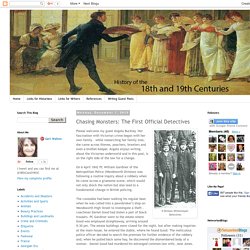
Her fascination with Victorian crime began with her own family – while researching her family tree, she came across thieves, poachers, brawlers and even a brothel-keeper. Angela enjoys writing about the Victorian underworld and in this post, is on the right side of the law for a change. On 6 April 1842 PC William Gardiner of the Metropolitan Police (Wandsworth Division) was following a routine inquiry about a robbery when he came across a gruesome scene, which would not only shock the nation but also lead to a fundamental change in British policing. The constable had been walking his regular beat when he was called into a pawnbroker’s shop on Wandsworth High Street to investigate a theft - coachman Daniel Good had stolen a pair of black trousers.
PC Gardiner went to the estate where Good was employed straightaway, arriving around 9.30 pm. The Metropolitan Police had been created 13 years earlier, in 1829. Her websiteTwitter Facebook. 19th Century Marriage Manuals: Advice for Young Wives. The Bride Adorned by Her Friend by Henrik Olrik, 1850.
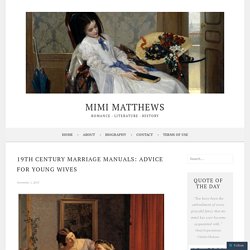
Covering a range of topics, including domestic economy, conjugal duties, and submission to one’s husband, the bulk of 19th century marriage manuals were directed at young wives occupying the middle and upper classes. These manuals were written by both men and women and were so numerous during the Regency and Victorian eras that some of the books contain notices wherein the author preemptively defends himself against future allegations of plagiarism. In author William Andrus Alcott’s 1837 book The Young Wife, or Duties of Woman in the Marriage Relation, Alcott begins by assuring his readers that: “Every chapter of this work was written many months before the appearance of certain recent publications involving, in some respects, similar sentiments.” Marriage manuals for young wives did contain many similar sentiments.
A Covent Garden Gilflurt's Guide to Life: The London Beer Flood. The Season in London Defined. The English custom of the elite in society passing months in London rather than their country homes began somewhere in the 17th century and continued to dominate the culture until well after WWI.

Roughly coinciding with the sitting of Parliament, the official Season launched in earnest after Easter and ran until August when Parliament adjourned. The purpose was originally a time for the aristocracy and landed gentry to gather in Town to discuss politics and workings of State, but quickly evolved into a period of socialization and entertainment. Events such as The Derby and the Royal Ascot horse races were essential to attend. Strolling or riding along the promenade Rotten Row in Hyde Park was on every agenda during the cooler afternoon.
18th and 19th Century: Sharpers, Shopkeepers, and the Georgian Era. Francis Grose defined a sharper in his eighteenth century dictionary as, "A cheat, one that lives by his wits.
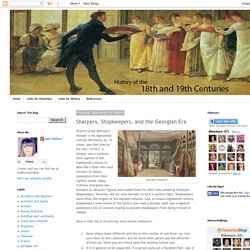
" In fact, a sharper was a common term applied in the eighteenth century to describe a thief who used trickery to obtain possessions from their rightful owner. Many ordinary Georgians saw sharpers as romantic figures and lauded them for their free-wheeling lifestyles. Shopkeepers, however, did not view sharpers in such a positive light. Shopkeepers were often the targets of the sharpers' attacks, and, to ensure eighteenth century shopkeeper's were aware of the tactics and ruses a sharper used, one magazine published a list of cautions hoping to prevent shopkeepers from being tricked or robbed.
Here is that list in its entirety (and almost verbatim): Contraception in the Regency - Guest Elizabeth Rolls - Alison Stuart - Writer. Where to Download Ackermann's Repository. 18th and 19th Century: Conversation Etiquette. 18th and 19th Century: Popular Drinks of the Georgian Era. Besides malt liquors, tea, or coffee, there were other popular drinks in the Georgian Era.
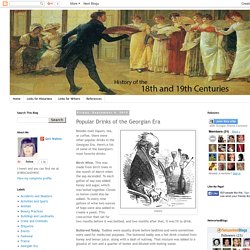
Here's a list of some of the Georgian's most favorite drinks: Birch Wine. Jane Austen's London. The George Cruickshank monthly print for September is a lively image of the Bartholomew fair, held at Smithfield from 1133 until Victorian moral outrage finally suppressed it in 1855.
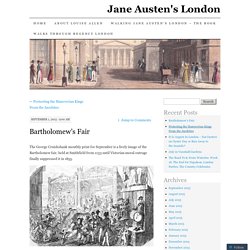
Its origins were in the cloth fair which provided much of the income for the priory and hospice dedicated to St Bartholomew that eventually became today’s Bartholomew’s Hospital (“Barts”). Fashionable Caps for 19th Century Matrons both Young and Old. Louise de Guéhéneuc, duchesse de Montebello by Pierre-Paul Prud’hon, early 19th century.
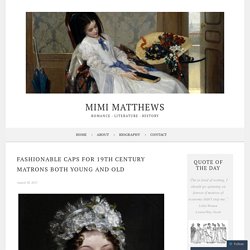
The 19th century cap was a modest necessity. Worn by spinsters and matrons both young and old, it neatly covered a lady’s hair while she was at home and abroad. At face value, such a basic article of clothing seems to have changed little throughout the century. However, a closer look at the fashionable caps of women of the 1800s reveals that styles did in fact subtly evolve. Through lace, ribbons, and trimmings, ladies of the age continually reinvented the cap, transforming it from what might otherwise have been a merely utilitarian scrap of fabric into a fashionable, feminine confection that said as much about a woman’s personal style as her French bonnets, cashmere shawls, and India muslin gowns.
The Gardens — The friends of Vauxhall Pleasure Gardens. Uld Mr Darcy afford a stately home today? A conversion chart, supposedly showing the modern-day worth of Jane Austen characters' fortunes, has surfaced on Twitter.

At first glance, it seems to show that Mr Darcy's supposedly vast 1803 fortune in Austen's novel Pride and Prejudice, worth $331,000 per year in modern US dollars, might not in fact stretch to quite the luxury of his 19th-century lifestyle if Darcy was alive today. It turns out that, if converted to 2013 GBP (the most recent year for which full information is available) using the percentage increase in the retail price index since the estimated time the novel was set, Mr Darcy's annual income of £10,000 in around 1803 would be worth £796,000 per year today.
That still probably wouldn't be enough to run a modern incarnation of Pemberley, his beautiful fictional stately home in Derbyshire, if its costs were anything like the costs of running real-life Derbyshire stately home Chatsworth House today (£4m per year). Historical and Regency Romance UK. 1746 map of London now available as an incredibly detailed Google map. The Centre for Metropolitan History and Museum of London Archaeology wanted a map that could help them visualise data from the 18th and 19th centuries.

They started by taking John Rocque’s 1746 map of London, putting the 24 parts together, then georeferencing it. (For non-cartographers, georeferencing is “the process by which an electronic image of the earth is located on to the earth in the right place, so that the features it depicts overlie the same features shown on a current measured reality”.) The results were overlaid onto a Google map, and voila! You can travel through London as it was in 1746, and, as a added bonus, see the differences between then and now by moving the StreetView icon around. Example: in 1746, Southwark was mainly a giant field, but look at all the blue lines on top of it! Dressing a Regency Woman. This blog post aims to give you a brief outline of how a Regency woman would be dressed.
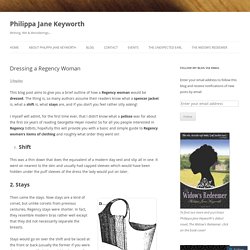
The thing is, so many authors assume their readers know what a spencer jacket is, what a shift is, what stays are, and if you don’t you feel rather silly asking! I myself will admit, for the first time ever, that I didn’t know what a pelisse was for about the first six years of reading Georgette Heyer novels! So for all you people interested in Regency tidbits, hopefully this will provide you with a basic and simple guide to Regency women’s items of clothing and roughly what order they went on! 18th and 19th Century: What are House Thoroughfares? Two Nerdy History Girls. A Fashionable Georgian Address: Berkeley Square. Berkeley Square c.1816 Since the Georgian era, Mayfair has been one of the most prestigious places to live in London. And during the Georgian era, Berkeley Square was one of the most desirable addresses.
Berkeley Square is actually an oblong garden that was, and is, surrounded by residential and commercial buildings. It’s named after John Berkeley, the 1st Lord Berkeley of Stratton (1602-1678). When Lord Berkeley built his town home on Piccadilly in 1675 for £30,000, he purchased the adjacent land north of his property. The five acres that encompass Berkeley Square were designed in 1730 by William Kent and is home to approximately 30 Maple trees.
During my last visit to London, I stayed near Berkeley Square and took frequent walks around the Square. Lansdowne House. How We Died 200 Years Ago, Compared to How We Die Today. Regency History: Almack's Assemby Rooms. The importance of Almack’s During the Regency period, Almack’s Assembly Rooms were at the heart of the London season. Their importance cannot be overstated. 18th and 19th Century: Penny Bloods and the Penny Dreadfuls. Penny Bloods, later called Penny Dreadfuls, were cheap nineteenth century publications that featured sensational and intriguing stories printed over a series of weeks. Originally, they told stories of pirates and highwaymen, and later focused on crime and mystery. At the time, they also cost buyers a penny and were cheaper than other fiction available, such as works by Charles Dickens, which cost about a shilling (or twelve pennies).
The weekly penny publications were extremely popular and millions of copies were sold. They first appeared in the 1830s and soon there were over 100 publishers producing them. The publications originally targeted young working class males and entertained readers by allowing them to escape into a thrilling fantasy world. 18th and 19th Century: Elizabeth Brownrigg, Executed for Torture. Elizabeth Brownrigg met and married a plumber named James Brownrigg, and, they created a nice life for themselves. They were wealthy enough to live in London on Fleet Street in Flower-de-Luce Court and owned a second home in Islington that they used as retreat. The couple were also lucky enough to become parents to a brood of fifteen (or perhaps sixteen) children, and, Mrs.
Brownrigg was said to be a loving, nurturing, and caring mother. Because of her motherly skills, Mrs. Brownrigg gained an appointment at Dunstan's parish. Special Headwear for the Grown-up Lady. If you asked a reader of Regency Romance what character would wear a cap, they would say a married woman or a spinster. But what makes a spinster, and why would they wear a cap? The reader would reply, an unmarried woman past her prime would wear a cap. But they might be vague on why. To signify she was off the marriage market? To indicate her age? The whole thing must have been confusing.
Word Wenches: Royal succession. Jo here. A Fascinating Montage of Early Film Footage of London. Check out the new Laughing Squid Store featuring unique gear, gadgets, apps, software and more! 18th and 19th Century: Types of Medicinal Cures in Georgian and Regency Eras. Various cures were available to the Georgian or Regency patient. For instance, leeches were used to bleed patients suffering from specks in their cornea. Exploring the world of late Georgian and Regency London. Regency History: The Prime Ministers of George III (1760-1820) English Historical Fiction Authors: In and Out of Jane Austen's Window.
Today's post is a year old, brought from my other blog. John Thomas Smith’s Remarkable Beggars. Hysteria in the Georgian Era. Hysteria was a catch-all term given to sufferers who were readily excited, highly nervous, or emotionally distressed. Georgian doctors claimed hysteria was brought on because of surprise created by joy, grief, fear, etc., and doctors also asserted that it affected people early in life—primarily between the age of puberty and thirty-five. Eighteenth century doctors also declared that hysteria could affect both sexes, male or females. How A Practical Joke Brought 19th Century London To A Standstill. In 1809 (or, by some accounts, 1810), a 21-year-old writer named Theodore Hook was strolling through central London with his friend, the architect Samuel Beazley, when he decided to put down a bet.
“I’ll lay you a guinea,” Hook wagered, pointing to a house opposite, “that in one week that nice quiet dwelling shall be the most famous in London.” The “nice quiet dwelling” in question was 54 Berners Street, the private residence of an unassuming widow known only as Mrs. Regency History: The Whigs and the Tories. Georgian politics With the UK’s General Election on 7 May fast approaching, politics is an inescapable topic of conversation.
It's About Time: Early 18C London Town Squares. Sheer cotton gauze dress, ca. 1815-20. 18th and 19th Century: Hysteria in the Georgian Era. Medical Blistering in the Georgian Era. History: Regency Evolution. 38 Vulgar Terms From the 19th-Century Urban Dictionary. The Regency period begins. The Victorians’ surprisingly liberal attitude towards gay men. 18th and 19th Century: The Footman and His Duties. 18th and 19th Century: Regency Priorities for Servants When Waiting on Men. The History of London. A Covent Garden Gilflurt's Guide to Life: A Salon Guest: Camp Followers in the Peninsular War. Fishwives and Firestarters: a load of old Billingsgate. English Historical Fiction Authors: "The Law of the Wise": Some Corporal and Capital Punishments of the Old Bailey.
Regency Hygiene: The Bourdaloue. 18th and 19th Century: Georgian Whist Players. The 19th Century British Post - Random Bits of Fascination. Winchester museum reflects on Battle of Waterloo. BBC - iWonder - Mary Wollstonecraft: 'Britain's first feminist' What to Expect (If You Were Expecting Unexpectedly in the 19th Century) Shannon Selin Dorothea Lieven, a diplomat in skirts - Shannon Selin. Ann Drewett, circulating library. 18th and 19th Century: Lady's Maid and Her Duties in the Georgian and Regency Era. Ten Days in a Madhouse: The Woman Who Got Herself Committed. The C18th British Secret Service under Pitt (1) File:Saloop - Rowlandson's characteristic Sketches of the Lower Orders (1820) - BL.jpg - Wikimedia Commons.
English Historical Fiction Authors: The Victorian Magical Elixir. 18th and 19th Century: Signalling and Shouting to Cabbies. 18th and 19th Century: Cato Street Conspiracy. Going to the Library In Georgian London. Paintings of Waterloo days after 1815 battle show the dead still laying where they fell. How Scams Worked In The 1800s : NPR History Dept. A Regency Era Breakfast: Various Times to Eat.
“Thank God all is well over”: family reactions to Pitt’s duel, May 1798. 18th and 19th Century: Maneuvering London's Streets in the Regency Era. 18th and 19th Century: Hawkhurst Smuggling Gang. Letterology: Printing at the Frost Fairs. The Perils of the Pavement – Winter in Georgian London. Mourning Becomes Her: Regency Mourning Dress & Customs » Risky Regencies. Regency History: A genuine Almack's voucher.
18th and 19th Century: Popular Millinery and Millinery Ornament Terms for the 1870s. The Entrance Hall in the 18th Century. The Unknown History of England's Domestic Servants (Full Documentary) Regency London: Let a romantic novelist be your guide. History - British History in depth: Beneath the Surface: A Country of Two Nations. A Regency Era Timeline 1816 in progress. Osprey Publishing - Military History Books - The Hidden Hand - Espionage and Napoleon. 18th and 19th Century: Regency Language of Cheats, Pickpockets, and Swindlers. Special Exhibition: A Carriage Enthusiast’s Paradise. The time when London’s streets were paved with wood.
Regency History: The history of the British Museum. Updating Early Modern Recipes (1600-1800) in a Modern Kitchen. Walking the Dog in Georgian London. Secrets and scandal: 5 super spies of the Georgian era. My Fanciful Muse: Regency Furniture 1809 -1815: Ackermann's Repository Series 1. A Peek Inside the Dining Room of Historic Lansdowne House.
A Peek Inside the Dining Room of Historic Lansdowne House. Regency England. Regency Colors Colours. City of Westminster Archives Centre. THE BRITISH LIBRARY - The world's knowledge. A PEER'S PRIVILEGE « Georgian Junkie. Ranks and Privileges of the Peerage, Essential Guide to the Peerage, People. The Regency Had No Crime. Common Regency Errors.